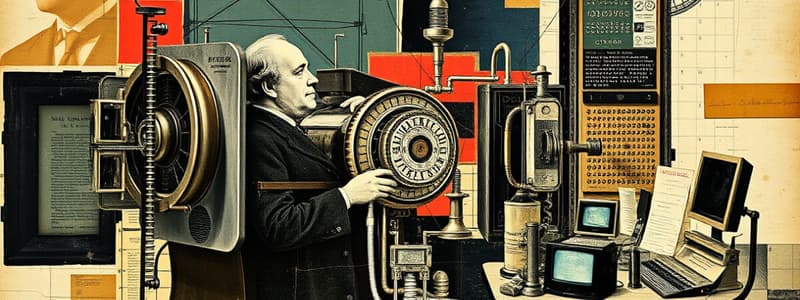Podcast
Questions and Answers
Charles Babbage's difference engine was powered by electricity.
Charles Babbage's difference engine was powered by electricity.
False (B)
Lady Augusta Ada King is recognized as the first female computer programmer.
Lady Augusta Ada King is recognized as the first female computer programmer.
True (A)
Herman Hollerith invented the first mechanical calculator in 1889.
Herman Hollerith invented the first mechanical calculator in 1889.
False (B)
The Atanasoff-Berry Computer is considered the first electronic digital computer.
The Atanasoff-Berry Computer is considered the first electronic digital computer.
Punched cards used by Hollerith were only for data storage and did not contribute to speed.
Punched cards used by Hollerith were only for data storage and did not contribute to speed.
Charles Babbage's analytical engine was designed for performing vector calculations.
Charles Babbage's analytical engine was designed for performing vector calculations.
Lady Augusta Ada King created instruction routines for the difference engine.
Lady Augusta Ada King created instruction routines for the difference engine.
Herman Hollerith's punched cards were only used in 1889 for computation without any mechanical advantage.
Herman Hollerith's punched cards were only used in 1889 for computation without any mechanical advantage.
William Hollerith and Herman Hollerith are the same person.
William Hollerith and Herman Hollerith are the same person.
The Atanasoff-Berry Computer served as a foundation for developments in electronic calculators.
The Atanasoff-Berry Computer served as a foundation for developments in electronic calculators.
The difference engine proposed by Babbage could run by electricity.
The difference engine proposed by Babbage could run by electricity.
The speed of Hollerith's punched cards did not contribute to data storage.
The speed of Hollerith's punched cards did not contribute to data storage.
Clifford Berry collaborated with John V. Atanasoff in designing the first electronic digital computer.
Clifford Berry collaborated with John V. Atanasoff in designing the first electronic digital computer.
Flashcards are hidden until you start studying
Study Notes
Charles Babbage
- Proposed the difference engine for solving differential equations, which utilized steam power and featured automatic calculations.
- Developed the analytical engine, recognized as the first general-purpose computer, after spending a decade on the difference engine.
- Lady Augusta Ada King contributed to the analytical engine by creating its instruction routines, making her the first female computer programmer.
Herman Hollerith
- In 1889, invented a data storage method using punched cards, which he inputted into a machine to mechanically compile results.
- The use of punched cards improved computational speed and accuracy, reducing the likelihood of errors.
John V. Atanasoff & Clifford Berry
- Designed and constructed the Atanasoff-Berry Computer (ABC), regarded as the first electronic digital computer.
- The ABC laid the groundwork for subsequent developments in electronic calculators and modern computing technology.
Charles Babbage and Lady Augusta Ada King
- Charles Babbage, a professor, proposed the difference engine to perform differential equations using steam power.
- The difference engine could execute calculations, store programs, and automatically print results.
- After a decade on the difference engine, Babbage was inspired to create the analytical engine, the first general-purpose computer.
- Lady Augusta Ada King, Babbage's assistant, developed the instruction routines for the analytical engine, earning the title of the first female computer programmer.
Herman Hollerith
- In 1889, inventor Herman Hollerith introduced punched cards to store data.
- Hollerith's machine mechanically compiled results from the punched cards, which allowed for quick data processing.
- Punched cards also served as a reliable storage method and reduced computation errors.
William Hollerith and Electronic Computers
- John V. Atanasoff and Clifford Berry designed the first electronic digital computer called the Atanasoff-Berry Computer (ABC).
- The ABC laid the groundwork for future advancements in electronic calculators and computing technology.
Studying That Suits You
Use AI to generate personalized quizzes and flashcards to suit your learning preferences.




